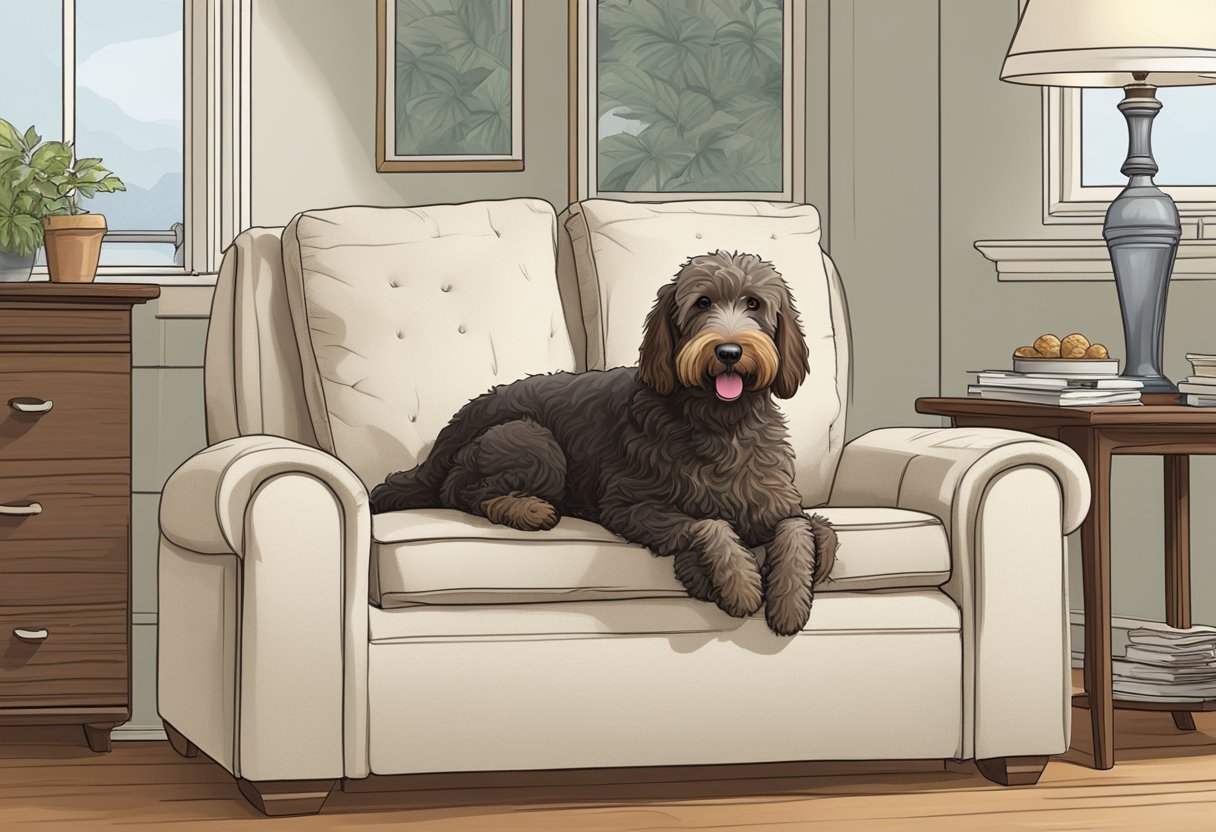Do Labradoodles Get Separation Anxiety? A Comprehensive Analysis
Labradoodles, a popular crossbreed between Labrador Retrievers and Poodles, are known for their friendly and affectionate nature. They make great family pets, however, like any other dog, they can develop behavioral issues when faced with certain situations. One such issue is separation anxiety, which can cause distress for both the Labradoodle and their owner.
Separation anxiety is a common concern for many dog owners. It is a condition in which a dog experiences extreme stress and anxiety when left alone or separated from their owner. This can result in various behavioral problems, including excessive barking, destructive behavior, and even self-harm.

As a Labradoodle owner, it is crucial to recognize the signs of separation anxiety and address them promptly.
Understanding your Labradoodle’s temperament and potential triggers for separation anxiety is essential for effectively managing and, when possible, preventing the condition. With the right approach and support, your Labradoodle can learn to feel more comfortable and secure during periods of separation.
Key Takeaways
- Recognize separation anxiety in Labradoodles by observing their behavior when left alone.
- Be mindful of your Labradoodle’s temperament to understand and address triggers for anxiety.
- Prevention and management of separation anxiety contribute to a comfortable environment for your Labradoodle.
Understanding Separation Anxiety
Separation anxiety is a common issue that many dogs, including Labradoodles, can experience. As an owner, it’s essential to recognize the signs and understand the potential causes of separation anxiety in your furry friend.

Your Labradoodle may exhibit separation anxiety through various behaviors. Common signs include excessive barking, whining, or howling when left alone, as well as destructive chewing, scratching at doors or windows, and even attempting to escape. In some cases, anxiety may lead to accidents in the house, even if your dog is properly house-trained.
There are several potential causes of separation anxiety in Labradoodles. One possibility is a lack of proper socialization in their early life. Puppies should be exposed to various people, pets, and environments to help them develop confidence and adaptability.
If your Labradoodle missed out on these experiences, they might feel anxious when separated from you.
Another cause could be a sudden change in routine or environment. Labradoodles, like many dogs, thrive on consistency and predictability. A major life change, such as a move or a change in your work schedule, can be stressful for your Labradoodle, resulting in separation anxiety.
Additionally, some Labradoodles may simply have a more anxious temperament due to genetics or their upbringing, making them more prone to experiencing separation anxiety.
As a Labradoodle owner, prevention and management of separation anxiety are crucial for ensuring your dog’s well-being. By understanding the signs and potential causes, you can take the necessary steps to address the issue and provide your Labradoodle with a happy, healthy, and comfortable environment.
Labradoodle’s Temperament and Separation Anxiety
As a Labradoodle owner, it is essential for you to understand your dog’s temperament and its susceptibility to separation anxiety. This breed is known for its high intelligence, making it capable of understanding and expressing emotions. This emotional sensitivity can contribute to feelings of nervousness when separated from their beloved owners.
PuppySpot is a reputable dog marketplace where you can browse and find compatible puppies right from the comfort of your home. They have placed over 200,000 puppies into homes in the US!

Labradoodles are highly intelligent and can be trained easily, allowing them to form strong bonds with their owners. Due to this connection, they may feel anxious when left alone for extended periods. They may exhibit signs of stress like excessive barking, whining, or destructive behavior.
To prevent this, ensure that you devote adequate time and attention to your Labradoodle. Engage in regular exercise, training, and playtime to establish a strong bond and keep them mentally stimulated.
Another factor contributing to a Labradoodle’s anxiety is their innate temperament. As a breed known for its friendly and sociable nature, a Labradoodle thrives in environments where they feel included as part of a family. It is important to provide a safe and secure environment that fosters their emotional well-being.
To summarize, as an owner of a Labradoodle, paying attention to their temperament, providing mental stimulation, and establishing a healthy bond is essential in reducing their likelihood of experiencing separation anxiety. By understanding and addressing their unique emotional and behavioral needs, you are contributing to their overall well-being and happiness.
Preventing and Managing Separation Anxiety
One essential step you can take to prevent separation anxiety in your Labradoodle is training. Ensure that you start training as early as possible to help your Labradoodle become well-behaved and feel secure in different situations. Socialization plays a key role in building confidence, so it’s vital to expose your dog to various people, animals, and environments.

Crate training is another effective method to prevent and manage separation anxiety. Teach your Labradoodle that the crate is their safe haven, a comfortable place where they can relax during your absence. Remember to make the crate a positive experience for your dog by using treats and praise.
Establish a consistent routine for your Labradoodle, as predictability can reduce anxiety. Schedule regular feeding, walking, playtime, and training sessions so your dog can anticipate and feel comfortable with these daily activities.
Ensuring your Labradoodle’s comfort is crucial when you’re away from home. Provide them with familiar bedding, toys, and soothing scents. Calming music or white noise can also help create a relaxing atmosphere.
Mental stimulation is essential to prevent boredom and anxiety in Labradoodles. Make sure you engage your dog with interactive toys, puzzles, or treat-dispensing toys to keep their minds occupied while you’re gone.
Proper training can be beneficial in managing separation anxiety. Teach your dog commands like “stay” or “relax” to help them cope with your absence. Practice leaving your dog alone for short periods, gradually increasing the time as they become more comfortable.
Finally, remember to create a safe space for your Labradoodle by providing a secure, comfortable area at home where they can relax and feel protected during your absence. Pay attention to their needs and use positive reinforcement techniques to build their confidence and trust in you.
Professional Aid for Separation Anxiety
If your Labradoodle is showing signs of separation anxiety, it’s crucial to seek professional help. A qualified dog trainer can provide valuable guidance on how to alleviate your dog’s stress. They can suggest specific exercises to help your Labradoodle become more comfortable when left alone, and they can also provide tips for creating a secure environment for your pet.

In some cases, a professional dog trainer may not be enough to address your Labradoodle’s separation anxiety. If the issue persists despite training efforts, consider consulting with a veterinarian. Your dog’s anxiety could be triggered by an underlying health issue or condition, such as pain or illness.
A veterinarian can thoroughly examine your Labradoodle to rule out any physical causes for their distress.
If your veterinarian determines that your dog’s separation anxiety is not linked to a medical condition, they may recommend medication to help manage their anxiety. Medications such as anti-anxiety drugs can be beneficial in reducing your dog’s stress levels when you’re away from home. However, these medications should always be used in conjunction with a behavioral modification plan provided by the dog trainer.
In conclusion, seeking professional aid from a qualified dog trainer and veterinarian is essential in addressing your Labradoodle’s separation anxiety. With their assistance, your dog can learn to cope with your absence and ultimately enjoy a happier, healthier life.
Wrap Up: Creating a Comfortable Environment
As a Labradoodle owner, it’s important to maintain a comfortable environment for your furry companion to minimize separation anxiety. Remember that Labradoodles are affectionate and thrive on companionship. Try to involve them in family activities whenever possible, and always ensure they receive plenty of affection.

When you need to leave your Labradoodle home alone, create a safe space for them—like a designated room or crate with their favorite toys and comfortable bedding. This space should be cozy, familiar, and provide a sense of security. Ease your Labradoodle into spending alone time in this environment by gradually increasing the duration and making it a positive experience.
Finally, encourage family members or trusted friends to visit and interact with your Labradoodle when you’re not around. This will provide your pet with additional companionship and help reduce separation anxiety. By following these tips, you can create a comfortable and loving environment for your Labradoodle.



![Fat Poodle [Poodle Obesity Guide]](https://poodle.club/wp-content/uploads/2022/12/fat-poodle-obesity-768x512.webp)



